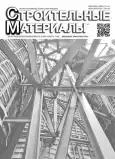Energy-saving technologies in civil engineering of the Chechen Republic
- Authors: Murtazaev I.S.1, Bekmurzayeva L.R.1, Saidumov M.S.1, Vitargova R.S.1
-
Affiliations:
- Grozny State Oil Technical University named after Academician M.D. Millionshtchikov
- Issue: No 7 (2025)
- Pages: 58-62
- Section: Статьи
- URL: https://rjsvd.com/0585-430X/article/view/688701
- DOI: https://doi.org/10.31659/0585-430X-2025-837-7-58-62
- ID: 688701
Cite item
Abstract
The existing methods and technologies of energy saving in civil engineering in the conditions of the Chechen Republic are considered. It is revealed that the main limitations of the energy-saving technologies and materials integration in construction are related to its cost increase. In this regard, methods of encouragement from government structures, government support of developers, financial programs, reduced taxation and other financial instruments should play the key role. It is proposed to use the alternative energy sources such as solar energy and deep Earth heat energy as an active energy saving system in the Chechen Republic. Developments in converting the city of Grozny districts to heating using the Khankalskoye field thermal waters have been known since the 1980s and seem to be very effective, as they do not require high costs for implementation.
Full Text
About the authors
I. S.-A. Murtazaev
Grozny State Oil Technical University named after Academician M.D. Millionshtchikov
Author for correspondence.
Email: ismail.murtazaev.2001@mail.ru
Postgraduate Student
Russian Federation, 100, Isayev Avenue, Grozny, 364021L. R. Bekmurzayeva
Grozny State Oil Technical University named after Academician M.D. Millionshtchikov
Email: eip-eco2017@yandex.ru
Candidate of Sciences (Geology)
Russian Federation, 100, Isayev Avenue, Grozny, 364021M. S. Saidumov
Grozny State Oil Technical University named after Academician M.D. Millionshtchikov
Email: saidumov_m@mail.ru
Candidate of Sciences (Engineering)
Russian Federation, 100, Isayev Avenue, Grozny, 364021R. S. Vitargova
Grozny State Oil Technical University named after Academician M.D. Millionshtchikov
Email: ruzanavitargova@gmail.com
Laboratory Assistant
Russian Federation, 100, Isayev Avenue, Grozny, 364021References
- Weng S., Song M., Tao W., Chen J., Chen H. Breaking the inertia of urban energy systems: Does the new energy demonstration city construction improve carbon unlocking efficiency? Renewable Energy. 2025. Vol. 244. 122672. https://doi.org/10.1016/j.renene.2025.122672
- Ovchinnikov E.V., Ovcharenko A.S. Problems and ways to reduce carbon dioxide emissions from transport, industrial production and utilities. Ekologiya Promyshlennogo Proizvodstva. 2021. No. 4 (116), pp. 28–32. (In Russian). EDN: VMUUDT. https://doi.org/10.52190/2073-2589_2021_4_28
- Evstratov V.S., Cherkas A.D. Review of energy-efficient construction projects in the world. Promyshlennoe i Grazhdanskoe Stroitel’stvo. 2016. No. 12, pp. 92–96. (In Russian). EDN: XISJEH
- Berardi U. Stakeholders’ influence on the adoption of energy-saving technologies in Italian homes. Energy Policy. 2013. Vol. 60, pp. 520–530. https://doi.org/10.1016/j.enpol.2013.04.074
- Murtazaev S.-A.Yu., Bekmurzaeva L.R., Salamanova M.Sh., Saidumov M.S., Vitargova R.S. Ways to decarbonize the construction industry as a modern challenge for obtaining low-carbon building materials. Stroitel’nye Materialy [Construction Materials]. 2024. No. 9, pp. 51–57. (In Russian). EDN: JSMWEK. https://doi.org/10.31659/0585-430X-2024-828-9-51-57
- Petrosov A.A. Cement production from thermal power plant ash. Gornyi Zhurnal. 2007. No. 11, pp. 50–51. (In Russian). EDN: ICBTNB
- Puzach V.G., Shustrov N.N., Chervyakov V.M., Shitikov E.S. On the possibility of increasing the efficiency of industrial production of building materials. Ekologiya Promyshlennogo Proizvodstva. 2019. No. 2 (106), pp. 49–53. (In Russian). EDN: FAPYNL
- Efimov V.I., Popov S.M., Korobova O.S., Efimova N.V. Improving environmental safety in light of the climate agenda in cement production. Bezopasnost’ Truda v Promyshlennosti. 2022. No. 3, pp. 55–60. (In Russian). EDN: TLPTPN. https://doi.org/10.24000/0409-2961-2022-3-55-60
- Danilovich P.A. Energy saving, alternative sources of energy, energy security. International Journal of Mechanical Engineering and Technology. 2018. Vol. 9.No. 3, pp. 405–412. EDN: XXNVDN
- Rakhmonov I.U., Ushakov V.Ya., Niyozov N.N., Kurbonov N.N., Mamutov M. Energy saving in industry. E3S Web of Conferences. 2021. Vol. 289. 07014. EDN: WBOOSN. https://doi.org/10.1051/e3sconf/202128907014
- Zyukin D.G. Polystyrene concrete. Rational use of energy resources. Stroitel’nye Materialy [Construction Materials]. 2022. No. 10, pp. 12–16. EDN: EOHUNG. https://doi.org/10.31659/0585-430X-2022-807-10-12-16
- Lesovik V.S., Puchka O.V., Vaisera S.S., Elistratkin M.Yu. New generation of building composites based on foam glass. Stroitel’stvo i Rekonstruktsiya. 2015. No. 3 (59), pp. 146–154. (In Russian). EDN: TQTUTB
- Ananyev A.I., Rymarov A.G., Titkov D.G. Energy-efficient buildings with external brick walls without soft insulation. Promyshlennoe i Grazhdanskoe Stroitel’stvo. 2023. No. 10, pp. 105–110. EDN: UADURX. https://doi.org/10.33622/0869-7019.2023.10.105-110
- Lapenko O., Skrebnieva S., Omelchenko K., Mashkov I. Modern systems of heat insulation buildings. Key Engineering Materials. 2020. Vol. 864 KEM, pp. 128–133. EDN: CATYFE. https://doi.org/10.4028/www.scientific.net/KEM.864.128
- Lu L., Chen J., Liu Y., Xu L., Ding Y. Optimizing building energy conservation by balancing energy savings and construction costs of two passive techniques using the VIKOR method: A case study in Chongqing. Journal of Building Engineering. 2025. Vol. 101. 111885. https://doi.org/10.1016/j.jobe.2025.111885
- Gutora T.V., Verkhovsky A.A. Design of FTS for high-rise buildings. Zhilishchnoe Stroitel’stvo [Housing Construction]. 2023. No. 12, pp. 8–11. (In Russian). EDN: HHKCZZ. https://doi.org/10.31659/0044-4472-2023-12-8-11
- Aksenov I.S., Konstantinov A.P. Analytical calculation of the complex stress-strain state of reinforced PVC profile under temperature load. Zhilishchnoe Stroitel’stvo [Housing Construction]. 2022. No. 11, pp. 19–28. (In Russian). EDN: ISOILC. https://doi.org/10.31659/0044-4472-2022-11-19-28
- Machigova F.I., Shaipov A.A., Bekmurzaeva L.R., Cherkasov S.V. Geochemical studies of thermal waters of the Khankala deposit in the Chechen Republic. Ustoichivoe Razvitie Gornykh Territorii. 2014. No. 2 (20), pp. 61–64. EDN: SILFIT
- Farkhutdinov A.M., Ismagilov R.A., Farkhutdinov I.M., Cherkasov S.V., Mintsaev M.Sh. Prospects for the use of thermal power waters of the Chechen Republic based on the experience of similar works in France (Paris basin). Vestnik of Tomsk State University. 2015. No. 398, pp. 257–264. EDN: VHTIXB https://doi.org/10.17223/15617793/398/40
Supplementary files











